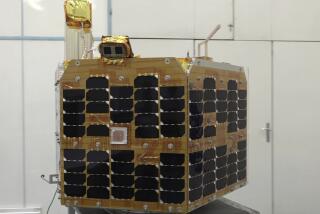Iran Reports Success in Guided-Missile Test
- Share via
TEHRAN — Iran successfully tested its first solid-fuel surface-to-surface missile, state-run Tehran radio reported Thursday.
The guided Fateh-110 missile was developed at the government-owned Aerospace Industries, the report said.
“Fateh-110, a super-modern surface-to-surface missile, functions with combined solid fuel, is able to cause great damage and finds targets with accuracy,” it said. “The missile is classified among Iran’s most efficient missiles.”
State television broadcast pictures of the missile taking off from a simple launcher at a desert site to cries of “Allahu akbar!”--”God is great!”--and footage of the impact crater.
The broadcast did not give the missile’s range, say when the test took place or provide other details.
Iran has built and tested several missiles, including the Shahab-3, which has a range of about 800 miles and, unlike the Fateh-110, uses a mixture of liquid and solid fuel.
Washington has said that the Shahab-3 enables Iran to hit Israel and U.S. troops stationed in the Persian Gulf.
U.S. State Department officials have said that Iran is a major recipient of missile technology from Russia, North Korea and China.
“We have long-standing concerns about Iran’s proliferation behavior, including its missile development and weapons-of-mass-destruction programs,” U.S. National Security Council spokeswoman Mary Ellen Countryman said.
But Iranian Defense Minister Ali Shamkhani, a candidate in next week’s presidential election, has said his country has a sophisticated domestic missile industry and needs no foreign technology. In an interview Thursday with Reuters, he rejected Western allegations that Iran was seeking to develop a nuclear capability.
“Don’t worry, we are reasonable people,” he said. “We have signed the Comprehensive Test Ban Treaty and the Nuclear Nonproliferation Treaty, and we will not try at all to subvert them.”
Iran had virtually no arms industry before the 1979 Islamic Revolution, when the country, under the U.S.-backed shah, bought virtually all of its weapons from Washington.
Tehran began an ambitious arms development program during the 1980-88 Iran-Iraq War to compensate for weapons shortages caused by a post-revolution U.S. embargo. Since 1992, Iran has unveiled its own tanks, armored personnel carriers, missiles and a fighter plane.
More to Read
Sign up for Essential California
The most important California stories and recommendations in your inbox every morning.
You may occasionally receive promotional content from the Los Angeles Times.










